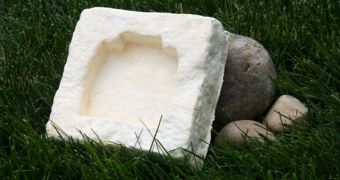The shipping and packaging industries consume vast amounts of energy to produce wraps and all sorts of packaging for the products they handle. The process releases important amounts of the dangerous greenhouse gas (GHG ) carbon dioxide (CO2) in the atmosphere. But now a new material is making the rounds at packaging companies around the United States. Obtaining the product releases 90 percent less carbon dioxide, and takes just on eight the energy required to produce conventional packaging materials. The material, called Mycobond™, is also capable of growing itself.
The strange product is created by combining inedible agricultural waste with mushroom roots, and is meant as a substitute for foam. Unlike any other materials that have the same function, Mycobond™ can also be used for a variety of other tasks, such as for instance fertilizing gardens as compost. The material is produced by Green Island, New York-based Ecovative Design. The company was founded by experts Gavin McIntyre and Eben Bayer, who are two former undergraduates at the Rensselaer Polytechnic Institute (RPI).
“We don't manufacture materials, we grow them. We're converting agricultural byproducts into a higher-value product. All of our raw materials are inherently renewable and they are literally waste streams. It's an open system based on biological materials,” McIntyre explains. An added advantage that stems from this is the fact that the price of the new packaging material will not vary when the price of oil and petroleum products does. Unlike other foam substitutes, it is not based on plastics.
The group is currently working on a way of reducing the energy required for a key process in obtaining Mycobond™. The process uses a agricultural waste starter material, which first needs to be sterilized. At this point, doing it requires a lot of energy, and the two are working with grant money from the US National Science Foundation (NSF) to fix the problem. After the sterilization stage, the mycelia (mushroom fibers) in the mix can begin growing. Additional money for the investigation comes from the US Department of Agriculture (USDA) Agricultural Research Service, the Environmental Protection Agency (EPA), and the New York State Energy Research and Development Authority.
Description: A packing material called Mycobond™, a composite of inedible agricultural waste and mushroom roots, grows itself. As a result, its manufacture requires just one eighth the energy and one tenth the carbon dioxide of traditional foam packing material. This time-lapse sequence shows a Mycobond™ packing component growing within a pre-designed mold.
Credit: Ecovative Design

 14 DAY TRIAL //
14 DAY TRIAL //